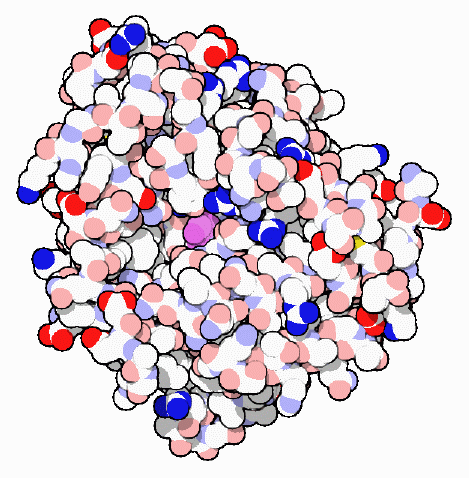|
Inhaltsübersicht | Nanomaschinen | Moleküle | Programme | Kurse | Fun | Links |
||
| > |
Penicillin-binding Protein
Bacteria pose a continual threat of infection, both to humans and to other higher organisms. Thus, when looking for new ways to fight infection, it is often productive to look at how other plants, animals and fungi protect themselves. This is how penicillin was discovered. Through a chance observation in 1928, Alexander Fleming discovered that colonies of Penicillium mold growing in his bacterial cultures were able to stave off infection. With more study, he found that the mold was flooding the culture with a molecule that killed the bacteria, penicillin.
Magic Bullet
Penicillin and other beta-lactam antibiotics (named for an unusual, highly reactive lactam ring) are very efficient and have few side effects (apart from allergic reactions in some people). This is because the penicillin attacks a process that is unique to bacteria and not found in higher organisms. As an additional advantage, the enzymes attacked by penicillin are found on the outside of the cytoplasmic membrane that surrounds the bacterial cell, so the drugs can attack directly without having to cross this strong barrier.Bursting Bacteria
When treated with low levels of penicillin, bacterial cells change shape and grow into long filaments. As the dosage is increased, the cell surface loses its integrity, as it puffs, swells, and ultimately ruptures. Penicillin attacks enzymes that build a strong network of carbohydrate and protein chains, called peptidoglycan, that braces the outside of bacterial cells. Bacterial cells are under high osmotic pressure; because they are concentrated with proteins, small molecules and ions are on the inside and the environment is dilute on the outside. Without this bracing corset of peptidoglycan, bacterial cells would rapidly burst under the osmotic pressure.Blocking Construction
Penicillin is chemically similar to the modular pieces that form the peptidoglycan, and when used as a drug, it blocks the enzymes that connect all the pieces together. As a group, these enzymes are called penicillin-binding proteins. Some assemble long chains of sugars with little peptides sticking out in all directions. Others, like the D-alanyl-D-alanine carboxypeptidase/transpeptidase shown here (PDB entry 3pte), then crosslink these little peptides to form a two-dimensional network that surrounds the cell like a fishing net.
Next: Penicillin Resistance
Last changed by: A.Honegger,